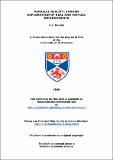Parallel reality : tandem exploration of real and virtual environments
Abstract
Alternate realities have fascinated mankind since early prehistory and with the advent of the computer and the smartphone we have seen the rise of many different categories of alternate reality that seek to augment, diminish, mix with or ultimately replace our familiar real world in order to expand our capabilities and our understanding. This thesis presents parallel reality as a new category of alternate reality which further addresses the vacancy problem that manifests in many previous alternate reality experiences. Parallel reality describes systems comprising two environments that the user may freely switch between, one real and the other virtual, both complete unto themselves. Parallel reality is framed within the larger ecosystem of previously explored alternate realities through a thorough review of existing categorisation techniques and taxonomies, leading to the introduction of the combined Milgram/Waterworth model and an extended definition of the vacancy problem for better visualising experience in alternate reality systems.
Investigation into whether an existing state of the art alternate reality modality (Situated Simulations) could allow for parallel reality investigation via the Virtual Time Windows project was followed by the development of a bespoke parallel reality platform called Mirrorshades, which combined the modern virtual reality hardware of the Oculus Rift with the novel indoor positioning system of IndoorAtlas. Users were thereby granted the ability to walk through their real environment and to at any point switch their view to the equivalent vantage point within an immersive virtual environment. The benefits that such a system provides by granting users the ability to mitigate the effects of the extended vacancy problem and explore parallel real and virtual environments in tandem was experimentally shown through application to a use case within the realm of cultural heritage at a 15th century chapel. Evaluation of these user studies lead to the establishment of a number of best practice recommendations for future parallel reality endeavours.
Type
Thesis, PhD Doctor of Philosophy
Rights
Creative Commons Attribution-NonCommercial-NoDerivatives 4.0 International
http://creativecommons.org/licenses/by-nc-nd/4.0/
Collections
Except where otherwise noted within the work, this item's licence for re-use is described as Creative Commons Attribution-NonCommercial-NoDerivatives 4.0 International
Items in the St Andrews Research Repository are protected by copyright, with all rights reserved, unless otherwise indicated.
Related items
Showing items related by title, author, creator and subject.
-
PolySocial reality for education : addressing the vacancy problem with Mobile Cross Reality
Allison, Colin; Davies, Christopher John; Miller, Alan Henry David (Immersive Education Initiative, 2013-06) - Conference itemWidespread adoption of mobile communications devices has led to people multiplexing their grounded reality, where they engage in face-to-face social interaction, with Web-based social networks and apps; concurrently emerging ... -
Reality and super-reality : properties of a mathematical multiverse
McKenzie, Alan (2020-08) - Journal articleEver since its foundations were laid nearly a century ago, quantum theory has provoked questions about the very nature of reality. We address these questions by considering the universe—and the multiverse—fundamentally as ... -
Realities of an 'Orkney way' : communicating perceptions of renewable energy in Orkney, Scotland
Friend, Sara (University of St Andrews, 2017-06-22) - ThesisOrkney is currently home to over 400 wind turbines and a growing marine energy industry, developing cutting edge technology for what could be called a global energy transition. Situated off the north tip of the Scottish ...


